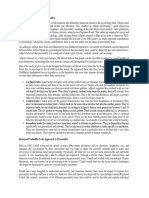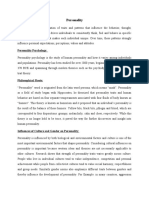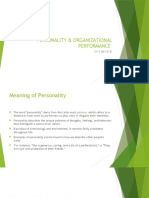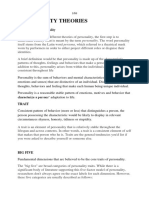The Big 5 Factors or O C E A N Theory of Personality Traits
The Big 5 Factors or O C E A N Theory of Personality Traits
Uploaded by
Sumit GhoshroyCopyright:
Available Formats
The Big 5 Factors or O C E A N Theory of Personality Traits
The Big 5 Factors or O C E A N Theory of Personality Traits
Uploaded by
Sumit GhoshroyOriginal Description:
Original Title
Copyright
Available Formats
Share this document
Did you find this document useful?
Is this content inappropriate?
Copyright:
Available Formats
The Big 5 Factors or O C E A N Theory of Personality Traits
The Big 5 Factors or O C E A N Theory of Personality Traits
Uploaded by
Sumit GhoshroyCopyright:
Available Formats
The Big 5 Factors or O C E A N theory of Personality Traits
Introduction: Many contemporary personality psychologists believe that there are five basic dimensions of personality, often
referred to as the "Big 5" personality traits. The five broad personality traits described by the theory are openness,
onscientiousness, extraversion, agreeableness, and neuroticism (OCEAN).
The need for the theory: Trait theories of personality have long attempted to pin down exactly how many different personality traits
exist. Earlier theories have suggested a various number of possible traits, including Gordon Allport's list of 4,000 personality
traits, Raymond Cattell's 16 personality factors and Hans Eysenck's three-factor theory.
However, many researchers felt that Cattell's theory was too complicated and Eysenck's was too limited in scope. As a result, the
five-factor theory emerged to describe the essential traits that serve as the building blocks of personality.
The theory: The "big five" are broad categories of personality traits. While there is a significant body of literature supporting this fivefactor model of personality, researchers don't always agree on the exact labels for each dimension. However, these five categories
are usually described as follows:
1. Openness: This trait features characteristics such as imagination and insight, and those high in this trait also tend to have a
broad range of interests. People who are high in this trait tend to be more adventurous and creative. People low in this trait are often
much more traditional and may struggle with abstract thinking.
2. Conscientiousness: Standard features of this dimension include high levels of thoughtfulness, with good impulse control and
goal-directed behaviors. Those high on conscientiousness tend to be organized and mindful of details.
3. Extroversion: Extroversion is characterized by excitability, sociability, talkativeness, assertiveness and high amounts of emotional
expressiveness. People who are high in extroversion are outgoing and tend to gain energy in social situations. People who are low in
extroversion (or introverted) tend to be more reserved and have to expend energy in social settings.
4. Agreeableness: This personality dimension includes attributes such as trust, altruism, kindness, affection and other pro-social
behaviors. People who are high in agreeableness tend to be more cooperative while those low in this trait tend to be more
competitive and even manipulative.
5. Neuroticism: Neuroticism is a trait characterized by sadness, moodiness and emotional instability. Individuals who are high in this
trait tend to experience mood swings, anxiety, moodiness, irritability and sadness. Those low in this trait tend to be more stable and
emotionally resilient.
Conclusion: It is important to note that each of the five personality factors represents a range between two extremes. For example,
extraversion represents a continuum between extreme extraversion and extreme introversion. In the real world, most people lie
somewhere in between the two polar ends of each dimension. Always remember that behavior involves an interaction between a
person's underlying personality and situational variables. The situation that a person finds himself or herself in plays a major role in
how the person reacts. However, in most cases, people offer responses that are consistent with their underlying personality traits.
You might also like
- Epq RDocument26 pagesEpq Rnesuma100% (5)
- Belbin Team Building Games and Exercises - Co-OperateDocument2 pagesBelbin Team Building Games and Exercises - Co-OperatePrapamobileNo ratings yet
- AllPort Theory of Trait PersonalityDocument4 pagesAllPort Theory of Trait PersonalityG Nagarajan0% (1)
- What Are The Big Five Dimensions of PersonalityDocument2 pagesWhat Are The Big Five Dimensions of Personalityanon_219222050No ratings yet
- The Big Five Personality TraitsDocument8 pagesThe Big Five Personality TraitsNeajNo ratings yet
- Roll Number:: Umar AliDocument6 pagesRoll Number:: Umar AliDil NawazNo ratings yet
- Personality TheoriesDocument139 pagesPersonality Theoriesvenkateswara Rao100% (1)
- The Big Five PersonalityDocument3 pagesThe Big Five PersonalityRabi'atul ApriantiNo ratings yet
- 5 Major Factors of Personality: Gordon Allport's Raymond CattellDocument6 pages5 Major Factors of Personality: Gordon Allport's Raymond CattellJona AddatuNo ratings yet
- 5 CharacyeridtcsDocument12 pages5 CharacyeridtcsJerry G. GabacNo ratings yet
- Trait Theory of PersonalityDocument14 pagesTrait Theory of PersonalityAnthony Joseph ReyesNo ratings yet
- Personality A AssignmentDocument12 pagesPersonality A AssignmentSahil MushafNo ratings yet
- Cherry 2020-What Is Personality-The Big 5 Personality-Impact Personaliti To HealthDocument14 pagesCherry 2020-What Is Personality-The Big 5 Personality-Impact Personaliti To Healthjuwita syafitri22No ratings yet
- Monaji ScriptDocument2 pagesMonaji ScriptKrishvasu99 KalaiNo ratings yet
- Personalit TheoryDocument10 pagesPersonalit TheoryrayonneeemdyNo ratings yet
- Trait Theory of PersonalityDocument3 pagesTrait Theory of PersonalityVi LeahNo ratings yet
- Trait TheoryDocument16 pagesTrait TheorySachin KumarNo ratings yet
- The Trait Approach To Personality Is One of The Major Theoretical Areas in The Study of PersonalityDocument17 pagesThe Trait Approach To Personality Is One of The Major Theoretical Areas in The Study of PersonalityClaire RoxasNo ratings yet
- What Is The Trait Theory of PersonalityDocument4 pagesWhat Is The Trait Theory of PersonalityCtmanis NyerNo ratings yet
- The Big Five Personality TraitsDocument15 pagesThe Big Five Personality TraitsyohannesNo ratings yet
- Personality-Part IIDocument10 pagesPersonality-Part IINnoorNo ratings yet
- Personality PsychologyDocument4 pagesPersonality PsychologyNoor SabaNo ratings yet
- Trait Perspectives On PersonalityDocument10 pagesTrait Perspectives On PersonalityCtmanis NyerNo ratings yet
- Lesson 6-Personality & Organizational Perfomance 2Document51 pagesLesson 6-Personality & Organizational Perfomance 2garashi juma100% (1)
- Презентация Характер и типы темпераментов 3Document51 pagesПрезентация Характер и типы темпераментов 3komalsaharan2001No ratings yet
- TRAIT THEORY - GROUP 3Document10 pagesTRAIT THEORY - GROUP 3anything0.atallNo ratings yet
- Type and Trait Approaches To PersonalityDocument11 pagesType and Trait Approaches To PersonalityFauzia SiddiquiNo ratings yet
- TopicUnit 3 PsychoDocument13 pagesTopicUnit 3 Psychoimmanuel5kant10No ratings yet
- Lecture No. 3Document64 pagesLecture No. 3sumaiya shafiqNo ratings yet
- Traittheories PersonalitytheoriesDocument16 pagesTraittheories PersonalitytheoriesnehadhamechaNo ratings yet
- Psychology Grand Assignment - Hassan Zeb LLB 4th - 56273Document14 pagesPsychology Grand Assignment - Hassan Zeb LLB 4th - 56273Hassan ZebNo ratings yet
- MPI Practical FormatDocument9 pagesMPI Practical Formatreshmasuresh2011No ratings yet
- Career CounselingDocument42 pagesCareer CounselingTobyprism TechnologyNo ratings yet
- Assignment of Psychology.Document7 pagesAssignment of Psychology.asadakhter239No ratings yet
- Assignment Submitted by 1001004: Definitions of PersonalityDocument13 pagesAssignment Submitted by 1001004: Definitions of PersonalitySumaiya SarwatNo ratings yet
- 1-8 UTS - Angeles - 3Document3 pages1-8 UTS - Angeles - 3Nathan Gerard Delos SantosNo ratings yet
- Personality: Unit B (Topic 3)Document47 pagesPersonality: Unit B (Topic 3)REHANRAJNo ratings yet
- Five Factor Model of PersonalityDocument2 pagesFive Factor Model of PersonalityRamsha ShahidNo ratings yet
- NEO FFiDocument10 pagesNEO FFiAsh LunaNo ratings yet
- Practical Epq (Eyesenck'S Personality Questionnaire)Document8 pagesPractical Epq (Eyesenck'S Personality Questionnaire)Rivisha SinghNo ratings yet
- The Big Five Model Is A ComprehensiveDocument15 pagesThe Big Five Model Is A ComprehensiveaidilshahzNo ratings yet
- Personality TheoriesDocument19 pagesPersonality TheoriesCarmen Cristina SobalvarroNo ratings yet
- Leadership TheoriesDocument6 pagesLeadership TheoriesMas Parno S IPNo ratings yet
- Dispositional and Trait TheoriesDocument21 pagesDispositional and Trait TheoriesEman ShoaibNo ratings yet
- Big Five InventoryDocument6 pagesBig Five Inventoryadyayda25No ratings yet
- Chapter 6: Personality: Objectives of This ChapterDocument54 pagesChapter 6: Personality: Objectives of This ChaptereyobNo ratings yet
- Uts 1Document11 pagesUts 1Adi SoNo ratings yet
- Introduction To PersonalityDocument32 pagesIntroduction To PersonalityShailaja RaghavendraNo ratings yet
- Acr 2305161153 0344879988 1Document15 pagesAcr 2305161153 0344879988 1ArundhatiNo ratings yet
- Lab Experiment I Personality Traits, Free Association Test and Reaction TimeDocument134 pagesLab Experiment I Personality Traits, Free Association Test and Reaction TimeFatima Malik100% (1)
- Chapter 6Document10 pagesChapter 6anchal singhNo ratings yet
- SSCTDocument13 pagesSSCTMehar100% (1)
- 16 PF Test ReportDocument15 pages16 PF Test ReportIndrashis MandalNo ratings yet
- Lecture 2Document26 pagesLecture 2Faisal AlNo ratings yet
- Personality Development and Soft SkillsDocument25 pagesPersonality Development and Soft Skillsthefunkies10No ratings yet
- Centrality of EvaluationDocument7 pagesCentrality of EvaluationDumebi AneneNo ratings yet
- Big Five Factors of PersonalityDocument21 pagesBig Five Factors of PersonalitySAM MATHEW NILAMBUR100% (1)
- Trait Theory of PersonalityDocument9 pagesTrait Theory of PersonalityJunaid SarwarNo ratings yet
- PERSONALITY THEORIES MA-3rd PKL HARYANADocument21 pagesPERSONALITY THEORIES MA-3rd PKL HARYANANavneet DhimanNo ratings yet
- Unit 1 PersonalityDocument7 pagesUnit 1 PersonalityUnnati BimalwarNo ratings yet
- Sociolinguistics partIIIDocument45 pagesSociolinguistics partIIIGorby ZumroniNo ratings yet
- Computational Thinking and 21st Century Problem Solving: Dr. Aman Yadav February 9, 2011Document31 pagesComputational Thinking and 21st Century Problem Solving: Dr. Aman Yadav February 9, 2011Galuh PradanaNo ratings yet
- Keys To Leading Masterful Sales Conversations PDFDocument13 pagesKeys To Leading Masterful Sales Conversations PDFMarcelo Partes de OliveiraNo ratings yet
- Article - How To Become A Destination Workplace PDFDocument2 pagesArticle - How To Become A Destination Workplace PDFhalefom abayNo ratings yet
- New CSP Lab ManualDocument44 pagesNew CSP Lab Manualloda lehsunNo ratings yet
- Creating A Positive School CultureDocument4 pagesCreating A Positive School Culturemaria grace ida100% (2)
- School LeadershipDocument27 pagesSchool LeadershipLOVELY JOY ROXASNo ratings yet
- Argyris Strategy ImplementationDocument11 pagesArgyris Strategy ImplementationDesirèe Donna Felicità100% (2)
- Lets Look at Your Life Experiences,,,,,, (Ethics)Document2 pagesLets Look at Your Life Experiences,,,,,, (Ethics)Emmanuel GarroteNo ratings yet
- Master of Business Administration: Semester 1 Semester 2Document2 pagesMaster of Business Administration: Semester 1 Semester 2Vipul SachdevaNo ratings yet
- 3058-Petrol Engine Service LabDocument60 pages3058-Petrol Engine Service LabiqbalNo ratings yet
- ZS FocusSheet - Pune - Business Technology AssociateDocument2 pagesZS FocusSheet - Pune - Business Technology AssociateShubham RajNo ratings yet
- Q4 Long QuizDocument1 pageQ4 Long Quiz2020-100394No ratings yet
- Module 1 - Fundamentals of CommunicationDocument53 pagesModule 1 - Fundamentals of Communicationcyrus12009No ratings yet
- (Shipra Vaidya (Auth.) ) Developing Entrepreneurial (B-Ok - CC)Document113 pages(Shipra Vaidya (Auth.) ) Developing Entrepreneurial (B-Ok - CC)Hindasyah AgustinNo ratings yet
- Teaching PlanDocument6 pagesTeaching PlanAngel Damo100% (1)
- Succeed at PsychometricsDocument8 pagesSucceed at PsychometricsAlice MitchellNo ratings yet
- Factors Affecting The Course Preferences Among Grade 11 HUMSS Students of Castillejos National High SchoolDocument3 pagesFactors Affecting The Course Preferences Among Grade 11 HUMSS Students of Castillejos National High SchoolKristine SanchezNo ratings yet
- Psychophysiological Characteristics of Football Players of Various Playing PositionsDocument9 pagesPsychophysiological Characteristics of Football Players of Various Playing PositionsismailegileduNo ratings yet
- Timeline and Theoretical Bases of Inclusive EducationDocument5 pagesTimeline and Theoretical Bases of Inclusive EducationMae Ann Perolino100% (1)
- CMucat Application FormDocument1 pageCMucat Application FormJiyan Litohon100% (1)
- Disadvantages of Performance AppraisalDocument6 pagesDisadvantages of Performance AppraisalRichard sonNo ratings yet
- My Dream Vacation EssayDocument3 pagesMy Dream Vacation Essaygqdknjnbf100% (2)
- ContohDocument193 pagesContohRizky RamaDhan PerDanaNo ratings yet
- Sociological Perspective of The SelfDocument9 pagesSociological Perspective of The SelfTrishaNo ratings yet
- 365DayPan DailyEnglishLessonPlanDocument367 pages365DayPan DailyEnglishLessonPlanManuel Sebastián Zamudio Adrada100% (2)
- A Lesson Plan in CNF4Document2 pagesA Lesson Plan in CNF4HappyNeversmilesNo ratings yet
- Self Efficacy and Motivation ExcellentDocument3 pagesSelf Efficacy and Motivation ExcellentBerelKempiNo ratings yet
- Chapter 1: IntroductionDocument3 pagesChapter 1: IntroductionJezebel SiongNo ratings yet

























































































